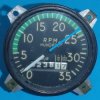talkingbob
Pre-takeoff checklist
- Joined
- Oct 21, 2011
- Messages
- 117
- Display Name
Display name:
JonC
Would LOVE some PA38 owners to chime in on this!
I was flying on a cross-country (1 hour 20 minute flight) recently and noticed the following indications on my engine-related gauges. The light blue lines in the attached photos indicate the position that the needle was in during cruise.
I was cruising at 4500 feet and leaning for "max power", which seemed to be where the top of the mixture lever was near the bottom of the "M" in the word MIXTURE to the left of the mixture lever. OAT was around 60F.
I was watching the gauges the whole flight and they never seemed to move really. Enriching slightly MAY have caused the Oil Temp to go down a TINY bit, but it was hard to tell.
Soo... Should I be concerned?
I was flying on a cross-country (1 hour 20 minute flight) recently and noticed the following indications on my engine-related gauges. The light blue lines in the attached photos indicate the position that the needle was in during cruise.
I was cruising at 4500 feet and leaning for "max power", which seemed to be where the top of the mixture lever was near the bottom of the "M" in the word MIXTURE to the left of the mixture lever. OAT was around 60F.
I was watching the gauges the whole flight and they never seemed to move really. Enriching slightly MAY have caused the Oil Temp to go down a TINY bit, but it was hard to tell.
Soo... Should I be concerned?





